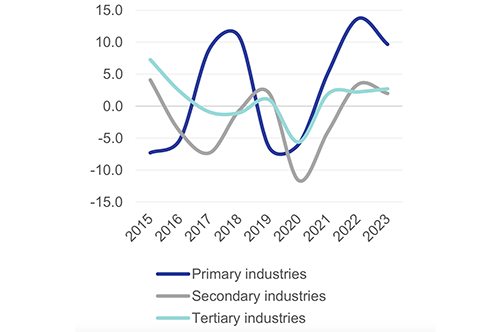The Namibian economy is on a positive trajectory when compared to fellow SADC states. This is as the latest figures show the domestic economy continued to demonstrate solid growth during the fourth quarter of 2023, with a real GDP expansion of 4.4%, exceeding the 3.3% growth rate observed in 4Q2022. This suggests that underlying economic momentum remained solid.
Commenting on this positive economic activity, the CEO of Sanlam Investments Tega Shiimi ya Shiimi noted that mineral exploration has been a large contributor to gross fixed capital formation and GDP.
Speaking to Inside Business about the latest figures, ya Shiimi said major contributors to the forward drive are offshore oil exploration and onshore mining activities related to uranium and gold.
“This has naturally attracted investments and boosted foreign reserves. To maintain this positive trend, the administration associated with foreign investment should be accommodative, and the ease of doing business should be a top priority in order to attract human capital and investments alike,” said ya
Shiimi.
In a report on these latest GDP figures for Q42023, stock brokerage Simonis Storm (SS) noted that on an annual basis, 2023 closed with a real GDP growth rate of 4.2%.
Moreover, in terms of contributions to GDP, primary industries saw an increase to 22.2% in 2023 from 20.6% in 2022, while secondary industries increased to 15.6% from 15.2% in 2022.
However, tertiary industries experienced a decrease to 53.4% in 2023 from 55.5% in 2022. Also, taxes less subsidies in products saw a moderate increase in contribution to GDP, rising to 8.9% from 8.7% in 2022.
“While this represents a moderation from the exceptional 5.3% growth recorded in 2022, it surpasses our earlier projection of 3.8% growth for the year,” SS stated.
The brokerage added that the growth rates for both 2021 and 2022 have been adjusted upwards.
“These revisions were widespread across 16 sectors of the economy, except for the ICT, professional, scientific and technical services industries, as well as the administrative and support services sector. The reason for these exceptions is attributed to updates in data,” SS noted.
Meanwhile, SS stated that the deceleration in overall growth primarily originates from the primary and secondary industries, whereas the tertiary industry continues to show steady growth.
“Preliminary National Accounts data shows that the primary industries drove growth, albeit at a slower rate, with a 9.7% increase, compared to 13.7% in 2022 now falling below 2018 levels. This slowdown in primary industries is mainly due to reduced demand for diamonds, leading to lower production levels. The growth rate of secondary industries also declined to 2.0% in 2023 from 3.4% in 2022, primarily due to a contraction observed in the manufacturing sector. Meanwhile, tertiary industries saw an improvement in growth, reaching 2.7% in 2023, compared to 2.2% in 2022, marking the highest growth rate since 2015. This growth was observed across most sectors,” the SS report reads.
The SS report reads: “In 2023, the main drivers of GDP growth were the electricity and water sector, experiencing a notable expansion of 27.9%, a significant increase from 11.9% in 2022. Additionally, the mining and quarrying sector contributed 18.9%, albeit showing a slowdown from the 24.0% recorded in 2022. The wholesale and retail trade sector also contributed positively with a 5.8% growth rate in 2023, along with the education sector at 3.5%”.
SS further pointed out that the construction sector emerged as the primary detractor from growth this year, with a rate of decline that improved to -0.2% in 2023 from -18.4% in 2022.
The brokerage added that conversely, the agriculture sector experienced a negative growth rate of 11.3%, while manufacturing recorded -3.2%, and the public administration and defence sector -0.68%, weighing down heavily on overall economic growth.
“Private consumption expenditure remains a crucial component of our economy, constituting 73.3% of GDP in 2023, compared to 75.4% in 2022. While growth continued on a positive trajectory, it slowed to 4.7% in 2023 from 9.5% in 2022. This deceleration can be attributed to constraints on consumers’ disposable income due to a high inflationary and interest rate environment,” SS commented.


